Have you ever considered adding arbors to your fence? They may not be the first thing that comes to mind when you think about enhancing your fence, but they can actually provide numerous benefits. In this article, we will delve into the advantages of adding arbors to your fence and how they can transform the look and functionality of your outdoor space. Whether you’re looking to create a more inviting entrance, increase privacy, or add a touch of elegance to your fence, arbors can be a fantastic addition. Read on to discover more about the benefits of adding arbors to your fence and how they can enhance your overall landscaping.
Arbors can serve as a beautiful focal point for your fence, adding charm and character to your outdoor space. Not only do they act as a decorative feature, but they also provide practical benefits. With an arbor, you can create a captivating entrance to your home or garden, making a lasting impression on visitors. Additionally, arbors can add privacy to your yard by acting as a natural barrier between your property and the outside world. This can be particularly beneficial if you have a fence that is not completely solid or if you want to create a secluded area within your yard. In the upcoming article, we will explore various types of arbors, how they can be incorporated into different fence designs, and offer practical tips for installation and maintenance. Stay tuned to uncover the full potential and benefits of adding arbors to your fence.
The Benefits of Adding Arbors to Your Fence
Arbors are beautiful and versatile structures that can enhance the aesthetics, privacy, and functionality of your fence. Adding an arbor to your fence can significantly increase its curb appeal and provide you with a shaded and sheltered area. Whether you want to create a welcoming entrance, grow climbing plants, or add lighting features, arbors offer endless possibilities. In this article, we will explore the different types of arbors, the reasons why you should consider adding them to your fence, factors to consider before installation, step-by-step guide for installation, decorative elements, maintenance tips, integration techniques, cost considerations, and much more. So, let’s dive in and discover the many benefits of adding arbors to your fence.
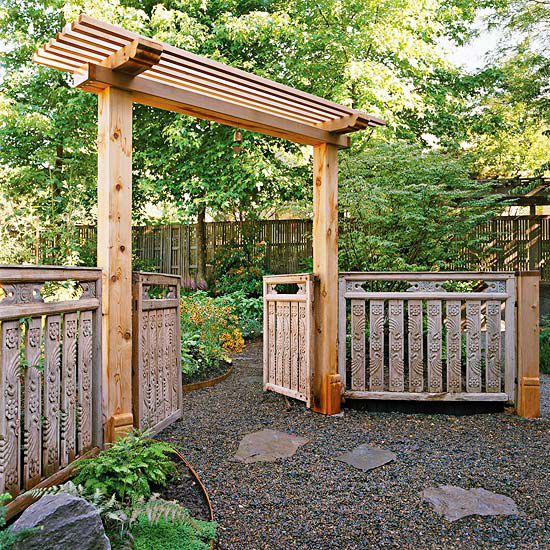
What are Arbors?
Definition and Explanation
Arbors are structures that consist of an overhead arch or framework typically made of wood, metal, or vinyl. They are designed to create a decorative entrance, provide shade, or support climbing plants. Arbors are often installed at the entrance of gardens, walkways, or as a focal point in outdoor spaces. They can also be attached to fences to enhance their appearance and functionality.
Different Types of Arbors
There are various types of arbors available, each with its own unique design and purpose. Some common types include:
- Pergola arbors: These arbors feature a flat overhead framework that provides partial shade and can support climbing plants.
- Arched arbors: These arbors have a curved top that provides a more decorative and elegant look.
- Gable arbors: These arbors have a triangular or gable-shaped top that adds height and architectural interest.
- Trellis arbors: These arbors have a lattice-style framework that allows climbing plants to grow and create a green wall effect.
Why Add Arbors to Your Fence?
Enhancing Aesthetics
Adding an arbor to your fence can significantly enhance its aesthetics. It acts as a focal point and adds visual interest to an otherwise plain fence. Whether you choose a simple wooden arbor or an arched arbor with intricate details, it can transform the overall look of your fence and create a welcoming entrance to your property.
Providing Privacy
Arbors can also provide additional privacy to your outdoor space. By attaching an arbor to your fence and growing climbing plants such as vines or flowering shrubs, you can create a natural barrier that blocks the view from prying eyes. This allows you to enjoy your outdoor space without feeling exposed to neighbors or passersby.
Increasing Curb Appeal
An arbor can significantly increase the curb appeal of your home. It adds a touch of elegance and charm that can make your property stand out in the neighborhood. Whether you are planning to sell your home in the future or simply want to make it more inviting, adding an arbor to your fence can make a positive impression on potential buyers or guests.
Creating Shade and Shelter
One of the main benefits of adding an arbor to your fence is the ability to create shade and sheltered areas in your outdoor space. By positioning the arbor strategically, you can create a shaded spot where you can relax, read a book, or have outdoor gatherings. During hot summer days, the shade provided by the arbor can make your outdoor space more comfortable and enjoyable.
Adding Functionality
Arbors can also add functionality to your fence by serving as a support for various outdoor elements. You can attach hooks or brackets to the arbor to hang potted plants, wind chimes, bird feeders, or outdoor decor. This not only adds visual interest but also maximizes the use of your outdoor space.
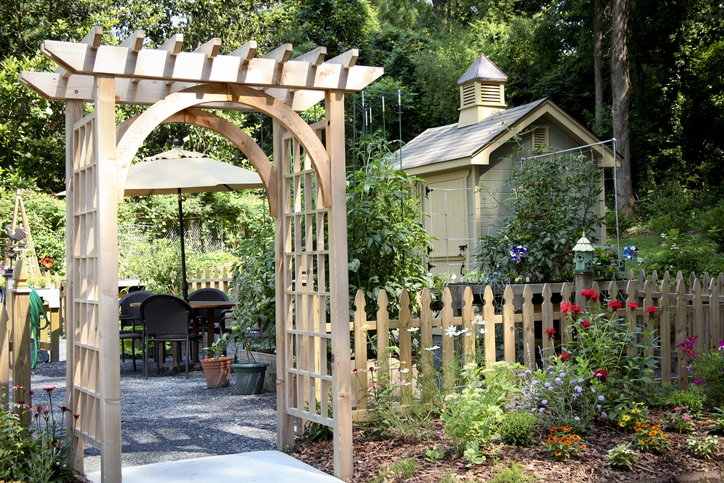
Factors to Consider Before Adding Arbors
Choosing the Right Style and Design
When adding an arbor to your fence, it is important to consider the style and design that will complement your existing fence and overall outdoor aesthetic. Whether you have a modern, traditional, or rustic fence, there is an arbor design that will suit your needs. Take into account the architectural style of your home and the surrounding landscape to ensure a cohesive and harmonious look.
Selecting Materials
Arbors are available in various materials, including wood, metal, vinyl, and composite materials. Each material has its own advantages and considerations. Wood arbors offer a natural and warm look but require regular maintenance such as staining or sealing. Metal arbors are durable and low-maintenance but can be more expensive. Vinyl and composite arbors mimic the look of wood but require minimal upkeep. Consider your budget, desired maintenance level, and the overall durability of the material before making a decision.
Considering Maintenance Requirements
Before adding an arbor to your fence, it is important to consider the maintenance requirements associated with it. Wood arbors may require regular staining or sealing to protect them from the elements. Metal and vinyl arbors are generally low-maintenance but may require occasional cleaning. Take into account your willingness and ability to perform regular maintenance tasks when choosing the type of arbor.
Examining Space and Size Constraints
Another crucial factor to consider is the available space and size constraints of your outdoor area. Measure the dimensions of your fence and outdoor space to ensure that the arbor will fit properly without overcrowding the area. Consider the height, width, and depth of the arbor to ensure it does not become overwhelming or obstructive to the surrounding landscape.
Step-by-Step Guide to Adding Arbors to Your Fence
Surveying and Preparing the Area
Before installation, survey the area where you plan to add the arbor. Clear any debris or obstacles that may hinder the installation process. Additionally, check for any underground utilities or cables to avoid damaging them during the installation.
Measuring and Marking
Measure the width of your fence to determine the appropriate size of the arbor. Use a tape measure and mark the desired location for the arbor on the fence. Ensure that the markings are level and centered.
Digging Post Holes
Using a post hole digger or a shovel, dig holes for the arbor posts. The depth of the holes will depend on the height and size of the arbor. As a general rule, dig holes at least one-third of the height of the arbor. Ensure that the holes are deep enough to provide stability and prevent the arbor from tipping over in strong winds.
Securing the Fence Posts
Insert the arbor posts into the prepared holes and use a level to ensure that they are straight and plumb. Fill the holes with concrete or gravel, compacting it around the posts for stability. Allow the concrete to dry and cure according to the manufacturer’s instructions before proceeding.
Attaching the Arbor
Once the fence posts are secure, attach the arbor to the posts using screws or brackets. Follow the manufacturer’s instructions for the specific arbor model you have chosen. Ensure that the arbor is level and securely attached to the fence posts.
Finishing Touches
After attaching the arbor, check for any gaps, loose screws, or imperfections. Make any necessary adjustments or repairs to ensure a seamless and polished look. Consider adding decorative elements such as trim, paint, or stain to further enhance the appearance of the arbor.
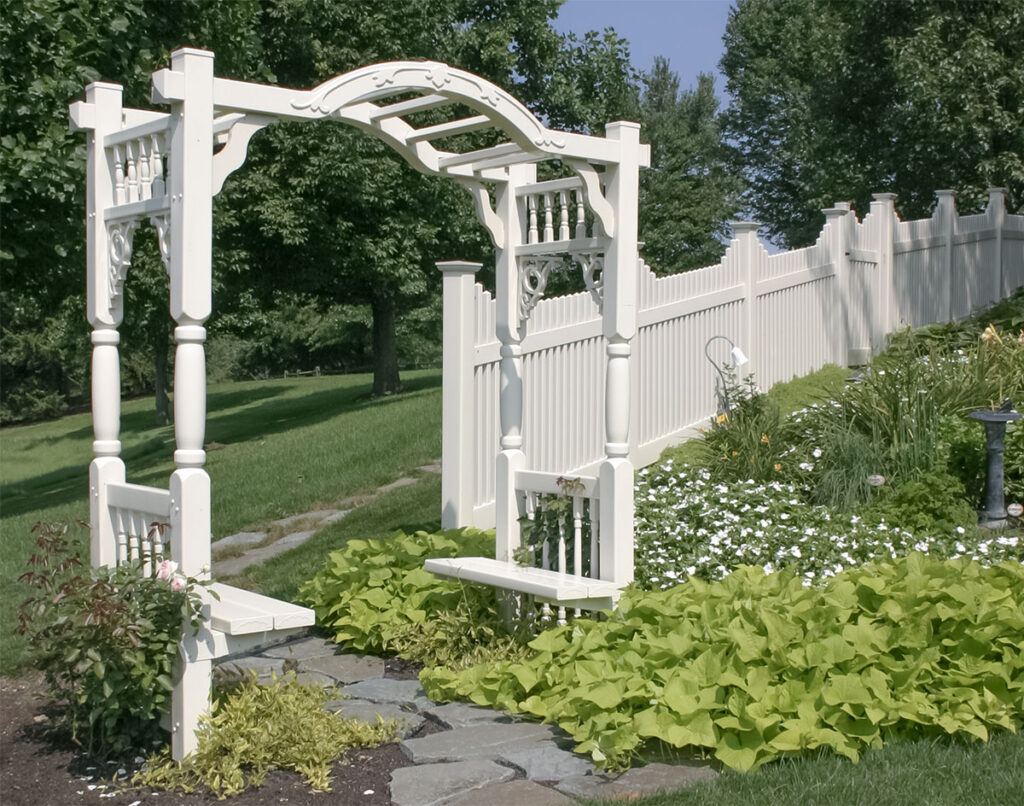
Installing Decorative Elements on Arbors
Choosing Ornamental Accessories
To further enhance the look of your arbor, consider adding ornamental accessories such as finials, decorative brackets, or lanterns. These accessories can add a personal touch and make your arbor truly unique.
Utilizing Climbing Plants or Vines
Take advantage of the structure of the arbor by growing climbing plants or vines. Consider plants such as roses, ivy, or clematis that can grow and twine around the arbor, creating a natural and picturesque element. Ensure that the plants you choose are suited to your climate and will not damage the arbor.
Adding Lighting Features
To extend the usability of your arbor into the evening, consider adding lighting features. Install string lights, solar-powered lanterns, or low-voltage pathway lights to create a warm and inviting ambiance. Lighting not only adds functionality but also enhances the beauty of the arbor, especially during nighttime.
Maintaining and Repairing Arbors
Routine Cleaning and Inspections
Regularly clean your arbor to remove dirt, debris, or mildew that may accumulate over time. Rinse the arbor with water and use a mild detergent or cleaning solution if necessary. Additionally, inspect the arbor for any signs of damage, loose screws, or rot. Address any issues promptly to prevent further damage.
Treating Wood for Longevity
If you have a wood arbor, it is important to treat it properly to ensure its longevity. Regularly apply a protective sealant or stain to protect the wood from moisture, UV rays, and pests. Follow the manufacturer’s instructions for the specific product you choose and reapply as needed to maintain the integrity of the wood.
Repairing Damaged or Broken Components
Over time, arbor components may become damaged or broken due to weather exposure or wear and tear. Replace any damaged or broken components promptly to ensure the stability and functionality of the arbor. If you are unsure how to make the repairs, consult a professional or refer to the manufacturer’s instructions.
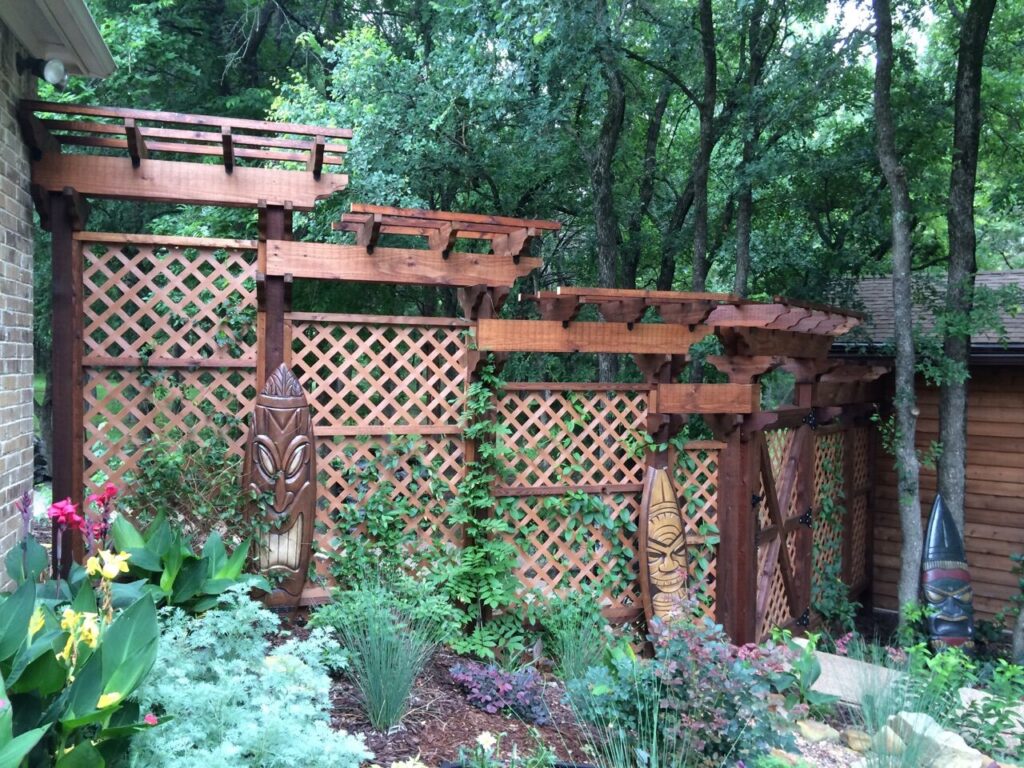
Arbor and Fence Integration Techniques
Seamless Design Incorporation
To create a harmonious look, integrate the design of the arbor with your existing fence. Consider matching the style, color, and finishes of the arbor to the fence to create a cohesive and unified appearance. This integration will make the arbor feel like an organic extension of the fence.
Matching Colors and Finishes
Matching the colors and finishes of the arbor and fence can create a visually pleasing aesthetic. Consider using the same paint or stain color for both the arbor and fence to create a seamless and coordinated look. Alternatively, choose complementary colors that enhance each other and create an eye-catching contrast.
Sturdy Connection Methods
When attaching the arbor to the fence, ensure that you use sturdy connection methods to guarantee stability and durability. Use quality screws, bolts, or brackets to secure the arbor to the fence posts. Reinforce the connections if necessary to prevent any wobbling or movement of the arbor.
Cost Considerations for Adding Arbors
Determining Budget
Before adding an arbor to your fence, it is important to determine your budget. The cost of an arbor can vary depending on the materials used, size, design, and additional features. Setting a budget will help you narrow down your options and find an arbor that fits within your financial means.
Comparing Material Costs
Consider the costs associated with different materials when choosing an arbor. Wood arbors are generally more affordable, while metal and vinyl arbors tend to be more expensive. Take into account the long-term maintenance requirements and durability of the materials to make an informed decision.
Factoring in Installation Expenses
In addition to the cost of the arbor itself, consider the expenses associated with installation. If you have adequate DIY skills, you may be able to install the arbor yourself, saving on installation fees. However, if you are unsure or lack the necessary tools and expertise, hiring a professional may be a better option.
Estimating Long-Term Value
While arbors may require an initial investment, consider the long-term value they bring to your property. Enhancing the aesthetics, privacy, and functionality of your fence can increase the value of your home and make it more appealing to potential buyers. Therefore, view the cost of adding an arbor as an investment in your property rather than a mere expense.
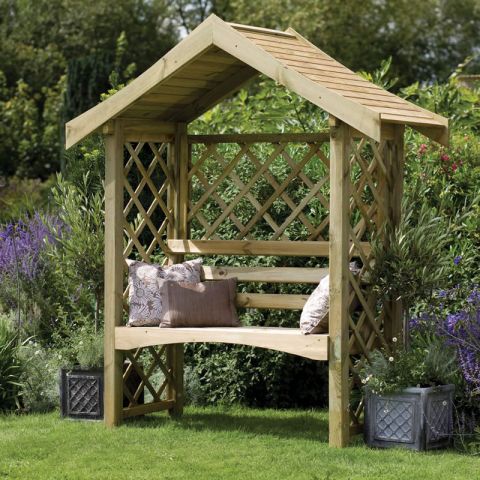
Arbors for Different Fence Styles
Arbors for Privacy Fences
If you have a privacy fence, adding an arbor can enhance its appearance and create a grand entrance. Choose an arbor with a decorative top or trellis-like sides to add visual interest. You can also grow climbing plants on the arbor to further enhance its privacy benefits.
Arbors for Picket Fences
Picket fences have a charming and traditional appeal. Adding an arbor to a picket fence can create a whimsical and inviting entrance. Consider an arched or gable-style arbor to complement the shape of the picket fence. You can also paint the arbor and fence in coordinating colors to create a cohesive and cheerful look.
Arbors for Chain Link Fences
Chain link fences are known for their practicality and durability. However, they may lack aesthetics. Adding an arbor to a chain link fence can soften its appearance and make it more visually appealing. Choose an arbor with a curved or arched top to add elegance and style.
Arbors for Vinyl Fences
Vinyl fences are low-maintenance and come in various styles, including privacy, picket, and ranch. Adding an arbor to a vinyl fence can amplify its aesthetic appeal and serve as a decorative focal point. Consider a vinyl arbor that matches the style and color of your vinyl fence for a cohesive and seamless look.
Arbors for Metal Fences
Metal fences are known for their strength and durability. Adding an arbor to a metal fence can create a striking and sophisticated entrance. Choose an arbor with ornate details or a sleek and modern design to complement the metal fence. Consider powder-coated metal arbors for added durability and weather resistance.
Arbors for Farm and Ranch Fences
Farm and ranch fences are typically functional and practical. Adding an arbor to a farm or ranch fence can add a touch of elegance and make a statement. Consider a gable or pergola-style arbor that matches the rugged and rustic appearance of the fence. You can use the arbor to hang outdoor tools, equipment, or even decorative farm-related items.
Popular DIY Arbor Designs and Projects
Simple Wooden Arbor
A simple wooden arbor is a versatile and easy-to-build option for DIY enthusiasts. It can be customized to fit any fence style or outdoor space. Use quality lumber, such as cedar or redwood, to ensure durability and resistance to rot. You can add decorative elements, such as lattice panels or finials, to personalize the design.
Arched Arbor with Gate
An arched arbor with a gate combines functionality and elegance. It serves as a welcoming entrance while providing privacy and security. The arched design adds height and visual interest to your fence. Consider using pressure-treated lumber and weather-resistant hardware for a long-lasting and low-maintenance structure.
Corner Arbor Bench
A corner arbor bench is a cozy and inviting addition to any fence. It provides a shaded and comfortable seating area where you can relax and enjoy the outdoors. The arbor can be built in a corner of your fence, maximizing the use of space. Consider adding cushions or pillows for added comfort.
Arbor Swing
An arbor swing adds a playful and whimsical element to your fence. It provides a relaxing and enjoyable spot to swing and unwind. The arbor can be designed to accommodate a swing, ensuring stability and safety. Consider using hardwood or metal for the swing frame to withstand the weight and movement.
Arbor Trellis
An arbor trellis combines the benefits of an arbor and a trellis. It provides shade, supports climbing plants, and adds an architectural element to your fence. The trellis design allows climbing plants to grow and intertwine, creating a lush and green backdrop. Consider adding an arbor trellis to a privacy fence to enhance its aesthetics and functionality.
Arbors and Property Value
Impact on Home Resale Value
Adding an arbor to your fence can significantly impact the resale value of your home. It enhances the overall curb appeal and makes your property more attractive to potential buyers. A well-designed and well-maintained arbor can create a positive and lasting impression, ultimately increasing the value of your home.
Attracting Potential Buyers
Potential homebuyers are often drawn to properties that have unique and standout features. Adding an arbor to your fence can make your home stand out from the competition. It adds a sense of elegance and charm that can attract and captivate potential buyers, increasing the chances of a successful sale.
Improving Overall Property Appearance
The addition of an arbor to your fence can significantly improve the overall appearance of your property. It creates a polished and finished look that enhances the beauty of both the fence and the surroundings. In turn, this can lead to a higher perceived value of your property and a more desirable living environment.
Comparing Arbors to Other Fence Enhancements
Arbors vs. Pergolas
While both arbors and pergolas are overhead structures, there are some key differences between the two. Arbors are typically smaller and often used as decorative entrances or supports for climbing plants. Pergolas, on the other hand, are larger and provide more shade and coverage. Pergolas are often used as outdoor living areas and can accommodate seating or dining areas.
Arbors vs. Gazebos
Gazebos are freestanding structures that provide a fully covered and enclosed space. They are larger and more substantial than arbors, offering more shelter and protection. Gazebos are often used as outdoor gathering spaces or for events. Arbors, on the other hand, are often attached to fences and serve as decorative entrances or focal points.
Arbors vs. Trellises
While arbors and trellises can both support climbing plants, they serve different purposes. Arbors are larger structures designed to create an entrance or a covered area. Trellises, on the other hand, are more compact and are typically attached to walls or fences. They are used to support the growth of climbing plants and create a vertical green wall effect.
Arbor Maintenance Tips for All Seasons
Seasonal Cleaning and Care
Regardless of the season, regular cleaning and care are necessary to maintain the beauty and functionality of your arbor. Remove any fallen leaves, debris, or twigs. Use a gentle detergent or cleaning solution to wash away dirt or mildew. Inspect the arbor for any signs of damage or wear and address them promptly.
Protecting Against Weather Elements
Different weather elements can impact the longevity and condition of your arbor. During hot summer months, consider providing shade by using a sailcloth or retractable awning. When winter approaches, cover the arbor with a weather-resistant tarp or a protective cover to prevent snow buildup or ice damage. Protecting your arbor against extreme weather conditions can extend its lifespan and ensure its continued enjoyment.
Preparing for Winter
Before winter arrives, it is important to prepare your arbor for the harsh weather conditions. Trim any overhanging branches that may pose a risk to the structure. Inspect the arbor for any loose screws or hardware and tighten them if necessary. Apply a protective sealant or paint to any exposed wood surfaces to prevent moisture damage. Taking these preventive measures can help your arbor withstand the winter months and stay in excellent condition.
Conclusion
Adding an arbor to your fence can bring numerous benefits to your outdoor space. From enhancing aesthetics and providing privacy to increasing curb appeal and creating a shaded area, arbors offer endless possibilities. Before adding an arbor, consider factors such as style, materials, maintenance requirements, and space constraints. Follow the step-by-step guide for installation and integrate the arbor with your existing fence. Utilize decorative elements, maintain and repair your arbor regularly, and consider the cost and value it brings to your property. With careful planning and execution, adding an arbor to your fence can transform your outdoor space into a welcoming and beautiful sanctuary. So, why not enhance your fence with an arbor and reap the numerous benefits it offers?
Remember to visit “http://fencedude.org/” for more articles, tips, and advice on all aspects of fences. Our website covers a wide range of fence-related topics and will be a valuable resource for all your fencing needs.